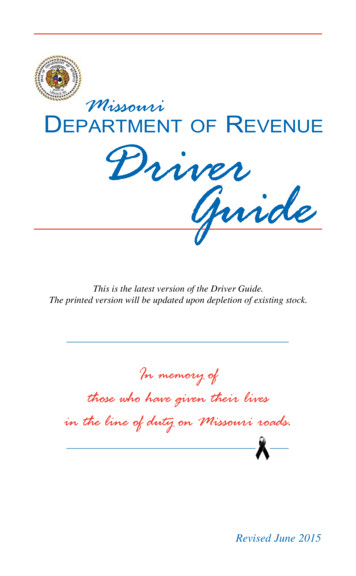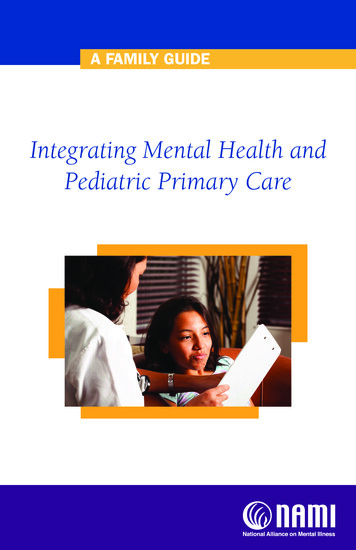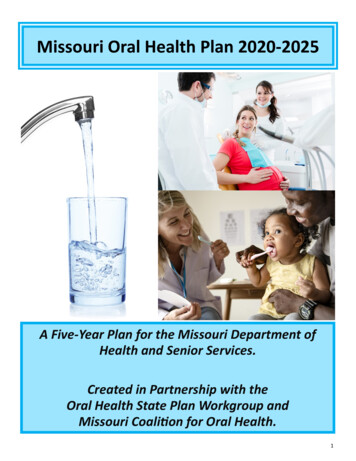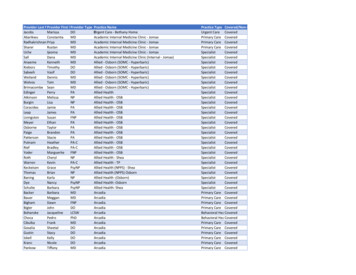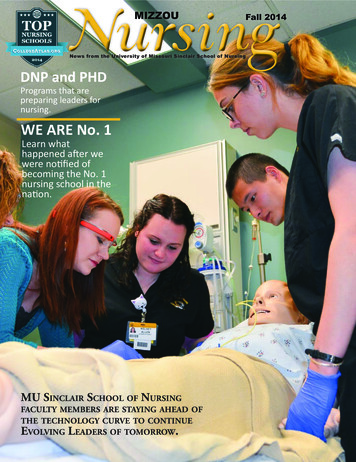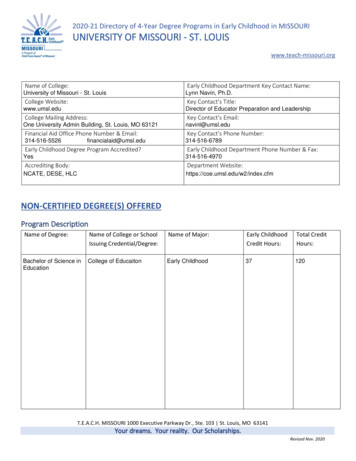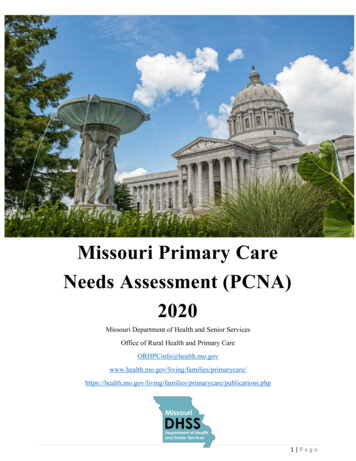
Transcription
Missouri Primary CareNeeds Assessment (PCNA)2020Missouri Department of Health and Senior ServicesOffice of Rural Health and Primary g/families/primarycare/publications.php1 Page
Thank You,Missouri Department of Health & Senior Services staff who contributed to this report:Office of Rural Health and Primary CareSara Davenport, ChiefLaura Hart, Primary Care Office ManagerAleesha Jones, Primary Care Office Grant ManagerSandy Srivastava, Associate Research/Data AnalystOffice of Health Care Analysis and Data DisseminationAndrew Hunter, ChiefHaley Stuckmeyer, Associate Research/Data Analyst2 Page
Table of ContentsExecutive Summary . 6Summary of Findings . 7Introduction . 11Purpose of the Primary Care Needs Assessment . 11The State of Missouri . 11Population . 11Population Age Groups . 14Race and Ethnicity . 15Geographic Highlights – Contiguous States . 18The Office of Rural Health and Primary Care . 19The Missouri Primary Care Office . 20The Conrad 30 State J-1 Visa Wavier Program. 21National Interest Waiver Program . 22Health Professional Student Loan and Loan Repayment Programs . 22Health Professional Shortage Area Designation . 34Missouri Primary Care Providers. 36Methodology . 42Health Indicator Selection . 42Health Status Indicators . 42Health Care Access Indicators . 43Ranking of Indicators. 44Health Status Indicators . 44Life Expectancy. 45Years of Potential Life Lost . 45Self-Reported Health Status . 46Ever Breastfed . 47Total Mortality . 48Infant Mortality . 48Heart Disease Mortality . 49Cancer Mortality . 50Chronic Lower Respiratory Disease (CLRD) Mortality . 51Stroke Mortality . 51HIV/AIDS Health Indicator. 52Asthma . 53Obesity . 533 Page
Diabetes . 54Hypertension . 55High Cholesterol . 56Depressive Disorders. 56Smoking . 57Health Access Indicators . 58Medicaid Enrollment . 58Medicare Enrollment . 60Uninsured . 60Population Living in Poverty. 61Population-to-Provider Ratios . 63Population to Primary Care Provider Ratio . 63Population to Mental Health Provider Ratio . 64Population to Dentist Ratio . 64Mammogram, Pap Smear, and Sigmoidoscopy/Colonoscopy Screenings. 65Preventable Hospitalizations . 66Dental Visits in the Last Year . 67Dental-Related Emergency Room (ER) Visits . 68Inadequate Prenatal Care . 68Low Birth Weight . 69Additional Barriers . 69Hospital Closures. 69Health Literacy . 71Education . 71Transportation . 72Internet and Telehealth . 73Unemployment . 73Coronavirus Disease 2019 (COVID-19) . 73Missouri Population . 73Economy . 74Hospital Operations . 75Local Public Health Agencies . 75Missouri Primary Care Office Efforts. 75Workforce Recruitment and Retention . 75Collaboration and Partnerships . 75Health Professional Student Loan and Loan Repayment Programs . 76National Health Service Corps. 774 Page
Code of State Regulations (CSR) . 77COVID-19 Efforts . 78Next Steps . 78Data Collection . 78Conclusion . 79Appendix A: Glossary of Terms . 80Appendix B: Greatest Unmet Need Ranking by County – Rank Order . 83Appendix C: Greatest Unmet Need Ranking by County – Alphabetical List . 86Appendix D: MICA (Missouri Information for Community Assessment) System . 89Appendix E: Health Status Quintile Points and Rankings by County . 91Appendix G . 98Appendix G: Endnotes/References . 1195 Page
Executive SummaryHealth Resources and Services Administration (HRSA) was created in 1982 and subsequently beganworking with state and territorial officials to improve access to quality health care services. Thiscollaboration resulted in HRSA awarding grants to state and territorial governments to fund theirstate Primary Care Office (PCO). 1 HRSA continues to collaborate with states to complete a PrimaryCare Needs Assessment (PCNA), every five years.The PCNA is a methodical technique used to identify unmet health and healthcare needs in Missouriand thus recommends changes to meet those unmet needs. The Missouri Statewide PCNA 2020analyzes Missouri’s unmet needs, lack of access to health care services, and evaluates resources andservices necessary to overcome disparities in Missouri.The Missouri Department of Health and Senior Services (DHSS), Office of Rural Health andPrimary Care (ORHPC), Primary Care Office (PCO) conducted a Missouri Statewide PCNA 2020 toidentify communities with the greatest unmet health care needs, disparities, and health workforceshortages, and the key barriers to accessing primary health care services.The Missouri PCNA 2020 examines 33 primary care health indicators subdivided into two groups: 18 Health Status Indicators examine the current state of health in Missouri by incorporatingthe following indicators: General population health, such as life expectancy and years of potential life lost; Health-promoting practices, such as breastfeeding; Prevalence of several notable diseases/health conditions; and Mortality rates for the total population, infants, and several leading causes of death. 15 Health Care Access Indicators examine Missouri residents’ access to various health careservices by considering the following indicators: Socioeconomic factors, such as poverty and lack of health insurance; Measures that may indicate a lack of access to preventive health care services, suchas dental-related emergency room (ER) visits and low birth weight; Usage of various types of health screenings; and Availability of several types of health care providers.The health status and health access indicators explore factors influencing the current state ofMissourians’ health and barriers associated with accessing primary health care services in Missouri.The health status and health care access indicators also provide information about the relative healthof each Missouri County. The PCO utilized the health indicators to identify where additional andnecessary health resources are needed most to meet the health care needs for underserved and highrisk populations.6 Page
Summary of FindingsThe Missouri PCNA 2020 report key findings include: HRSA has designated most of Missouri as a Primary Care Health Professional Shortage Area(HPSA) in medical, dental, and mental health disciplines. Rural counties were consistently identified as the counties ranked with the greatest unmetneeds in all but one health indicator. The HIV/AIDS health indicator demonstrated that urban counties were ranked withthe greatest unmet needs but comparatively four of the ten counties were rural. The southeastern region of the state, which is predominantly rural, was identified as having agreater instance of unmet needs, as compared to all other Missouri regions. Based on the analysis of health indicators, the areas with greatest unmet health needsidentified were primarily clustered in the southern part of Missouri, particularly in thesoutheast and south central areas. Moreover, 22 of the 23 Missouri counties with the greatest unmet health care needs werelocated south of the Missouri River. Only one county (Linn) was located north of the Missouri River, in the northeasternregion, as shown in Figure 1 and Figure 2 below. Furthermore, this is consistent with the findings of the 2015 Missouri PCNA, 2demonstrating nominal changes since 2015. Refer to Appendix B for a comprehensive list of counties in rank order, associated withgreatest unmet needs overall. For alphabetical order, refer to Appendix C. Figure 1 provides a list of the 23 counties that demonstrate the greatest overall unmet needs. Figure 2 illustrates the Missouri counties with the greatest overall unmet health care needs.Figure 1: Counties with the Greatest Unmet Needs regonWayneWrightNew 7110101Health CareAccess 223219212209208207204203200OverallPrimary CareNeeds Rank115114113112111110109108107106BRFSS RegionSoutheastern RegionSoutheastern RegionSoutheastern RegionSoutheastern RegionSoutheastern RegionSoutheastern RegionSoutheastern RegionSoutheastern RegionSoutheastern RegionSoutheastern Region7 Page
utlerTexasSt. 93Southeastern RegionCentral RegionSoutheastern RegionCentral RegionSouthwestern RegionSoutheastern RegionSouthwestern RegionSoutheastern RegionSoutheastern RegionSouthwestern RegionNortheastern RegionSoutheastern RegionCentral RegionFigure 2: Areas with Greatest Overall Unmet Health Care Needs – County Map8 Page
Figure 3 and Figure 4 demonstrate the Missouri counties with the greatest need for improvement inthe health status indicators.Figure 3: Table of Counties with Greatest Unmet Need – Health Status Indicators – Top , New MadridStoddardWashingtonRipley, Linn, Laclede, HenrySt. FrancoisReynolds, CarterWayne, Madison, ScottWrightOregon, Benton, RandolphBuchananHealth Status Rank11511411311211010910810410310198979493Figure 4: Health Status Indicators: Areas with Greatest Unmet Health Care Needs - County Map9 Page
Figure 5 and Figure 6 demonstrate the greatest challenges with health care access.Figure 5: Table of Counties with Greatest Unmet Need – Health Access Indicators – Top QuintileCountyRipleyOregonPemiscot, Iron, Wayne, Shannon, OzarkWright, DentDouglasDunklin, Mississippi, Reynolds, McDonald,Texas, Sullivan, DallasCarterSt. ClairMorganNew Madrid, Benton, StoneHealth Care Access Rank1151141091071069998979693Figure 6: Health Status Indicators: Areas with Greatest Unmet Health Care Needs - County Map10 P a g e
IntroductionPurpose of the Primary Care Needs AssessmentThe Missouri PCNA 2020 identified areas exhibiting the greatest unmet health care needs,disparities, and health workforce shortages within Missouri. The health disparities discussed in thePCNA demonstrate the differences which analytically and harmfully impact the Missouripopulations and counties. The PCNA also identified the key barriers experienced by thosecommunities in accessing health care services. Additionally, serving as a guide for public healthofficials and other stakeholders, the PCNA is a valuable tool utilized to determine where appropriateand crucial resources are needed most.Accessible primary health care services are so significantly salient that the importance cannot beover-emphasized. “Primary health care has been proven to be a highly effective and efficient way toaddress the main causes and risks of poor health and well-being today, as well as handling theemerging challenges that threaten health and well-being tomorrow.” 3During the provision of primary health care services, the first signs of depression, cancer, andchronic disease are often identified. 4 Primary health care resources are key elements in themaintenance of health and the prevention and treatment of disease. Additionally, a population’soverall health serves to positively affect an area’s economic growth. 5 Primary health care servicesare vital to the health of Missourians in identifying medical and mental health care needs for furtherevaluation and treatment.Missouri continues to experience a massive shortage of primary care providers. Additionally,Missouri’s vast rural areas are burdened by greater distances to providers and limitations associatedwith technologic access to providers, including telehealth services. Missouri continues to facechallenges in distance standards, transportation, health insurance coverage, health literacy,workforce shortages, and health behaviors.In rural areas, access is compounded by hospital closures and unit closures, transportation andeconomic barriers all within the changing environment of Missouri. This places much hindrance onhealth outcomes and resources available to underserved areas. Access to timely, high-qualityprimary care services is necessary for obtaining and maintaining improved health acrossMissourians’ life spans.The State of MissouriPopulationMissouri is a predominantly rural state (86%) located in the Midwest region of the United States(U.S.). Missouri is comprised of 115 counties, including, St. Louis City, an independent city whichfunctions as a county. Of the 115 counties, 16 are classified as urban and 99 are classified as rural. 6A county is considered rural if there are fewer than 150 people per square mile. Additionally, acounty must not contain parts of a central city in a Metropolitan Statistical Area (MSA) to beconsidered rural.Of the more than 6.1 million Missouri residents, 2.07 million, or approximately 34%, live in ruralareas. According to the Health in Rural Missouri Biennial Report 2018-20196, from 2007-2017,rural areas overall have experienced less than ( ) 1% population increase (urban populationincreased by 5.5% during the same time period). Additionally, 16 rural counties had population11 P a g e
losses of greater than ( ) 5%. Five rural counties experienced population growth of 8%. Thesecounties were adjacent to urban counties. Of the 99 total rural Missouri counties, 64 (65%)experienced population decline. Statewide, 16 rural counties had a 5% decline in population.According to the HRSA Shortage Designation Management System (SDMS), Missouri has a total of7,323 primary care, mental health, and dental health providers, of which 1,645 (22%) practice inrural counties. Even though 34% of Missouri’s total population lives in rural areas, only 22% ofavailable healthcare providers deliver services to rural Missourians. More providers practice inurban areas, as compared to rural, of which 78% provide services to the 66% urban residents. Thisdeficit and difference further demonstrates and necessitates programs and recruitment and retentionefforts to increase the number of providers practicing in rural areas.Figure 7: Rural/Urban County Classification Map, Missouri, 2020.Source: United States Census Bureau, Small Area Health Insurance Estimates. Population Highlights – Population Distribution: 5 of the most populous urban counties in Missouri are St. Louis, Jackson, St. Louis City, St.Charles, and Greene. 7 26 Missouri rural counties have a population of 10,000. 7 6 Missouri rural counties have a population of 5,000. 712 P a g e
Figure 8: County Population Distribution MapSource: Missouri Department of Health and Senior Services, Bureau of Health Care Analysis and Data Dissemination.13 P a g e
Population Age GroupsFigure 9: Missouri Total Population by Age GroupMissouri Total Population by Age Group85 ER 5371,5700150000300000450000Source: United States Census Bureau, 2019: American Community Survey 5-Year Estimate In 2019, the largest (5-year) age group in rural areas was the 55-59 year olds, as compared tothe largest age group for the urban population, 25-29 year olds. 6,8Senior PopulationFor the purpose of this PCNA, senior populations are comprised of individuals age 65 and older.In 2019, according to the U.S. Census Bureau, Missouri has an estimated senior citizen (65 )population of 1,006,725. 8 By 2030, according to the Missouri Economic Research and Information Center (MERIC),persons over the age of 65 will represent more than one-fifth of all Missourians. 9 By 2030, MERIC projects that there will be 1.4 million senior citizens in Missouri, whichdemonstrates an 87% population increase from 2000. 9 In 2019, the percentage of county population in Missouri for age 65 and older was less than19% per county in urban areas. 814 P a g e
Missouri’s older populations comprised a greater part of the rural communities, as compared tourban areas. However, both rural and urban Missouri experienced similar aging progressions.Interestingly, both groups saw an approximate 2% decline for the under 25 year old population and acorresponding 3% increase in the senior population. This further demonstrates the growing olderadult population in all of Missouri. Longevity can be linked to healthier habits but also demonstratesthe need for social systems to continue to care for the Missouri aging population.Figure 10: Percent of Residents Age 65 by County MapSource: Missouri Department of Health and Senior Services, Bureau of Health Care Analysis and Data Dissemination.Race and EthnicityAccording to the U.S. Census Bureau, over 82% of the Missouri population identified as white. Thepopulation distribution tables illustrate the total Missouri population distribution regarding race andethnicity, according to the U.S. Census survey data from 2013-2017. 1015 P a g e
Total Missouri Population Distribution - RaceWhite82.4%Black or African American11.6%American Indian and Alaska Native0.4%Asian1.9%Native Hawaiian and Other Pacific Islander0.1%Total Missouri Population Distribution - EthnicityHispanic or Latino4%Not Hispanic or Latino96%Racial Diversity in Missouri Rural CountiesOther Race1%Two or more races2%Asian1%Black or AfricanAmerican3%White93%16 P a g e
Racial Diversity in Urban Missouri CountiesOther Race1%Two or more races3%Asian3%Black or AfricanAmerican16%White77%Even though Missouri’s rural counties are less racially and ethnically diverse compared to urbancounties, the diverse persons who live in rural areas should have access to care and be able to avoidisolation. However, fewer people identify themselves as African American or Black, AmericanIndian/Alaska Native, Asian, Native Hawaiian and other Pacific Islander residing in rural areas.Based on the U.S. Census survey data from 2013-2017: Approximately 7% of rural residents identified as Non-White, compared to 23% of urbanresidents. In addition, more than half (54 of 99) of the rural counties had 5% of their populationidentified as African American or Black, American Indian/Alaska Native, Asian, NativeHawaiian, or other Pacific Islander. Those identifying as Black/Non-Hispanics comprised of the largest non-white group in bothrural and urban areas in Missouri. In urban areas, Black/Non-Hispanics represented 16% of the total urban population. In rural areas, Black/Non-Hispanic represented 3% of the total rural population. Missouri’s overall total Black/Non-Hispanic population of approximately 12% wascomparable to the U.S. National average of approximately 13%. The largest number of Black/Non-Hispanic residents reside in rural southeast Missouri. However, 3 rural counties represent a larger Black/Non-Hispanic population, as compared toother rural counties. Pemiscot (27%), Mississippi (24%), and New Madrid (16%). Missouri’s 4% total Hispanic population is relatively small, especially when compared to theoverall U.S. Hispanic population of 17%. Missouri’s total Hispanic population (4%) consists of 1% of the total rural population and3% of the total urban population. This equates to 3% of the 34% total rural population and5% of the 66% total urban population being Hispanic.17 P a g e
Geographic Highlights – Contiguous StatesMissouri is tied with Tennessee with the most contiguous states (8) in the U.S. Missouri is borderedby Iowa in the north; Illinois, Kentucky, and Tennessee in the east; Arkansas in the south; andOklahoma, Kansas, and Nebraska in the west. 11Geographic Highlights – Size and Other Features Missouri is named after the Missouri Native American tribe. Missouri Capital: Jefferson City Missouri state flower: white hawthorn. Missouri state bird: blue bird. Missouri state animal: Missouri mule. Missouri is the top p
Primary Care (ORHPC), Primary Care Office (PCO) conducted a Missouri Statewide PCNA 2020 to identify communities with the greatest unmet health care needs, disparities, and health workforce shortages, and the key barriers to accessing primary health care services.
